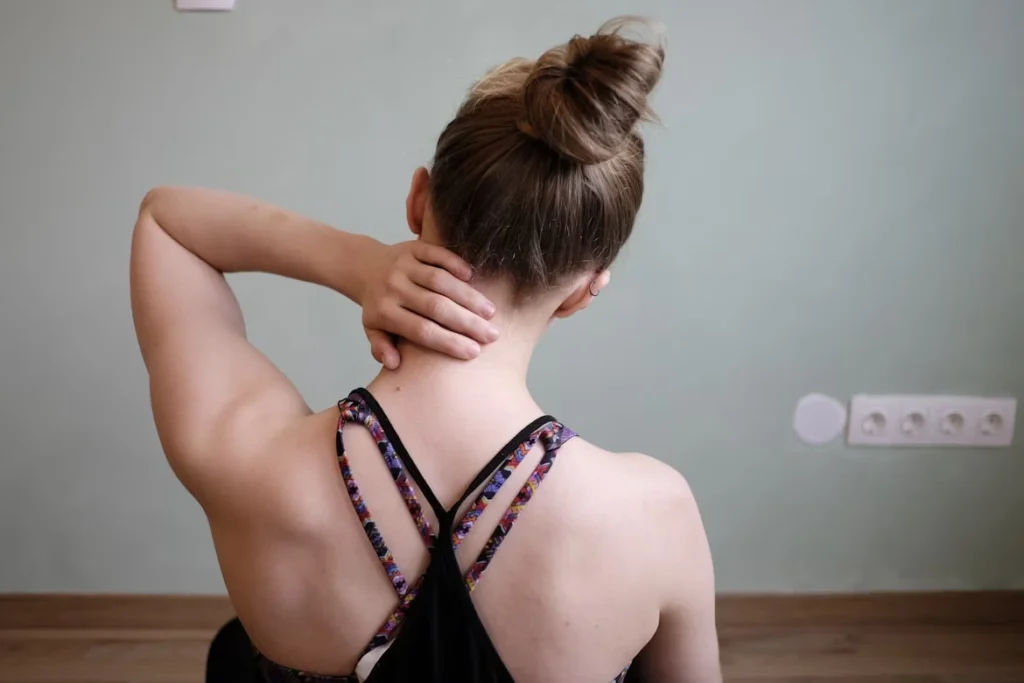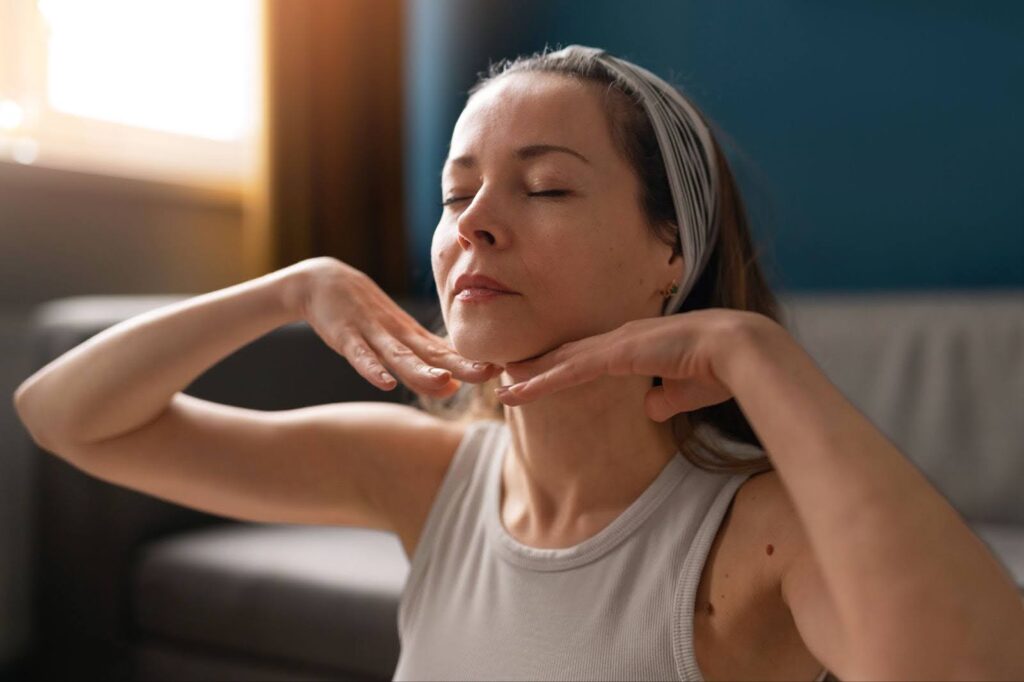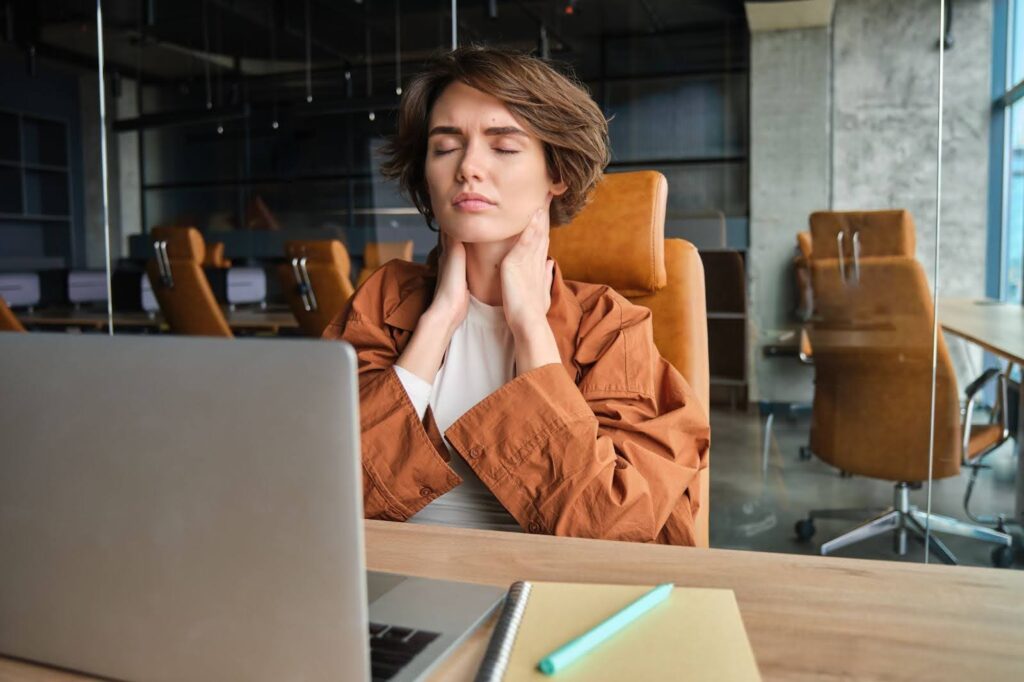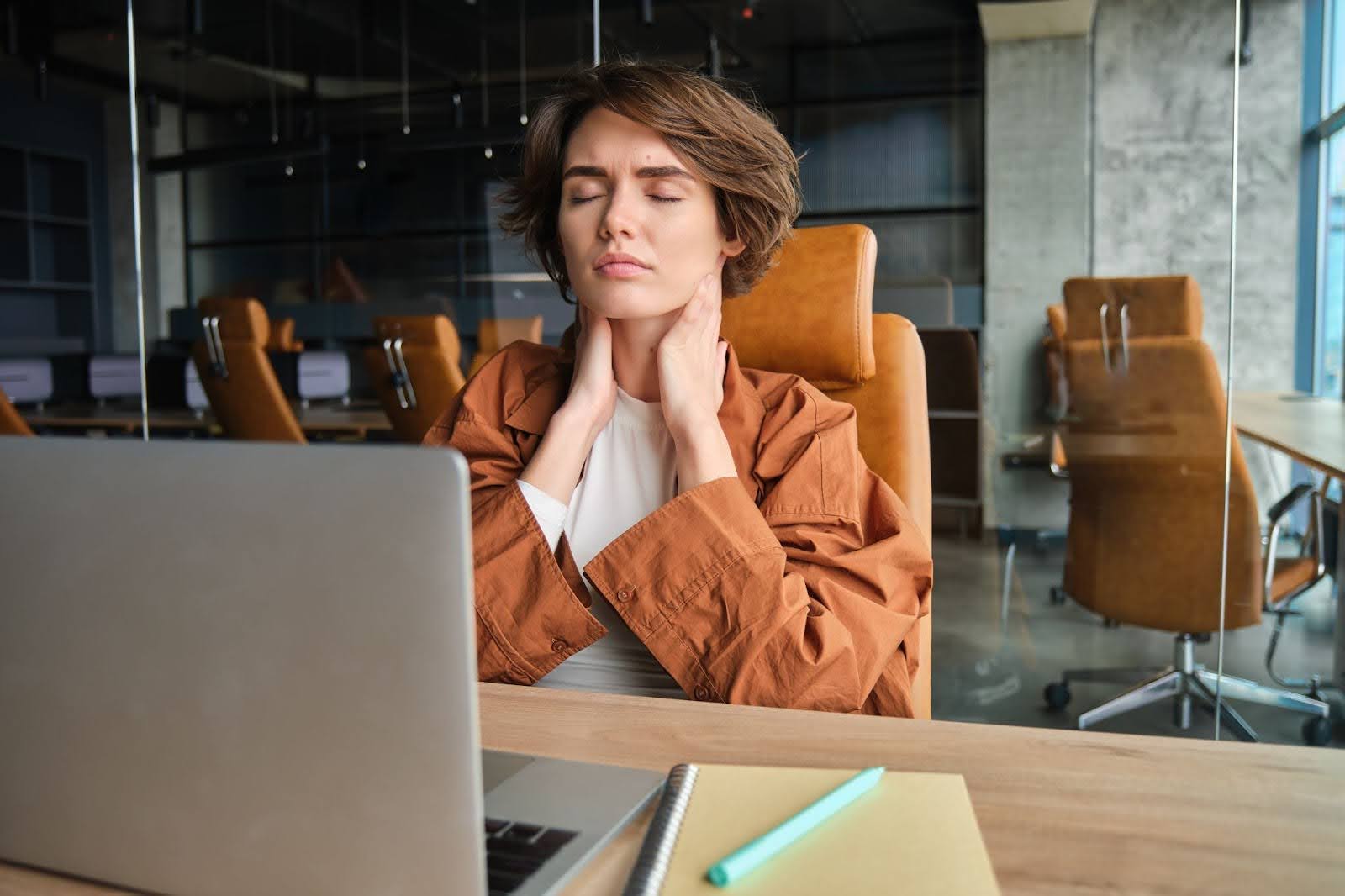In today’s digital age, we spend more time than ever on phones, tablets, and computers. While this connectivity offers convenience, it also comes with a physical cost: tech neck. This modern condition, also often referred to as text neck syndrome, phone or computer neck, includes neck pain from sitting at a desk, stiffness, and muscle fatigue caused by prolonged forward head posture while using digital devices. Whether you’re texting, scrolling, gaming, or working at a desk all day, the strain on your neck and upper spine adds up, sometimes silently, until discomfort turns into chronic pain.
At Moore MyoWorx, we’re seeing more patients reporting symptoms of tech neck: tight shoulders, tension headaches, reduced neck mobility, and even tingling in the arms or hands. These issues can develop gradually, but if left unaddressed, they may lead to more serious conditions like herniated discs or nerve compression.
The good news? Tech neck is both preventable and treatable. With the right posture strategies, ergonomic adjustments, and targeted muscle therapy, you can relieve the pain and stop further damage. In this blog post, we’ll explore what tech neck is, why it happens, and most importantly how to fix neck posture before it gets worse.
What Is Tech Neck?

Tech neck is a modern musculoskeletal condition caused by prolonged forward head posture, most commonly from extended use of smartphones, laptops, tablets, and other digital devices. When you tilt your head forward to look down at a screen, it increases the load on the cervical spine. Over time, this posture places excessive strain on the muscles, tendons, and joints of the neck and upper back.
While the head weighs around 10–12 pounds in a neutral position, tilting it forward by just 15 degrees can increase the effective weight on the neck to about 27 pounds. At 60 degrees, the strain can exceed 60 pounds. This constant stress can alter muscle balance, reduce mobility, and put pressure on spinal structures.
The rise in screen time for work, entertainment, and communication has made tech neck increasingly common among all age groups, including children and teens. Poor workstation ergonomics, long hours of sitting at the desk, and lack of physical movement further contribute to the development of this condition.
Tech neck isn’t caused by one single activity, but rather the repeated, long-term effects of poor posture while using technology. Without proper intervention, this posture imbalance can lead to more severe musculoskeletal issues over time.
Is tech neck genetic?
No, tech neck is not genetic. It’s a postural condition that develops from repeated behaviors and environmental factors, particularly device use, not inherited traits.
Does tech neck cause a double chin?
Tech neck can contribute to the appearance of a double chin over time. Constantly looking down can weaken neck muscles and lead to a breakdown of the structure of the skin causing the loss of firmness and definition of the jaw line.
Tech Neck Symptoms

Tech neck symptoms often begin subtly but can progress if left unaddressed. One of the most common signs is neck pain or stiffness, especially after long periods of screen use. People with tech neck may feel soreness in the shoulders, upper back, or between the shoulder blades. The muscles in the neck and upper trapezius often feel tight or fatigued, and range of motion can become limited over time.
Tension headaches are another frequent complaint, usually starting at the base of the skull and radiating upward. Some individuals experience numbness or tingling in the arms or hands, caused by nerve compression from poor posture. You might also notice jaw tension, eye strain, or even dizziness due to prolonged forward head position.
Postural changes are also common. People with tech neck often develop a rounded upper back and forward-tilting head, which can become more pronounced over time. In children and teens, these changes can occur rapidly due to developing muscles and increased device use.
Some people also notice tech neck wrinkles, horizontal lines on the front of the neck, that form from constantly looking down. These can be an early cosmetic sign of poor posture.
Symptoms tend to worsen the longer poor posture is maintained, which is why early recognition and intervention are crucial.
Can tech neck affect breathing?
Yes, tech neck can affect breathing. Forward head posture compresses the chest cavity and diaphragm, which can restrict lung expansion and make breathing shallower or less efficient.
How to test for tech neck?
A simple test is to stand sideways in front of a mirror and observe your posture. If your ears are noticeably forward of your shoulders or your head juts out in front of your torso, you may have signs of tech neck. A physical therapist or clinician can perform a more detailed postural assessment.
Moore MyoWorx Tech Neck Treatment

At Moore MyoWorx, we approach tech neck treatment with a comprehensive strategy that targets not just the symptoms, but the root causes of postural imbalance and muscle dysfunction. Unlike conventional treatments that may rely solely on temporary pain relief, our method is focused on restoring proper muscle function and supporting long-term recovery through neuromuscular rehabilitation.
The first step in treating tech neck at Moore MyoWorx is a detailed functional assessment. We evaluate how your muscles are working together (or compensating) during movement, particularly around the cervical spine, shoulders, and upper back. Many patients with tech neck have developed dysfunctional movement patterns due to prolonged forward head posture, which can result in weakened stabilizing muscles and overworked compensatory muscles.
We use our proprietary TM20 device and exercise protocols to release tight, restricted muscle and fascia tissues that contribute to pain and stiffness. This gentle, targeted technique helps reset muscle tone and reduces nervous system overactivity, two key contributors to chronic tension and poor posture. Unlike aggressive massage or passive therapies, the Moore MyoWorx approach focuses on reactivating proper muscle control so your body can begin to function as it was designed.
Once mobility is restored, we incorporate custom therapeutic exercises to strengthen the deep neck flexors, shoulder stabilizers, and core muscles. These exercises are designed specifically for your body’s needs and are aimed at rebuilding support for the head and spine. We also provide postural training and ergonomic guidance to help you avoid falling back into the habits that caused tech neck in the first place.
Many of our patients experience significant improvements in computer posture, reduced neck pain, fewer headaches, and enhanced breathing after just a few sessions. If you’re struggling with tech neck, our integrative, evidence-based approach can help correct the issue before it becomes a more serious, long-term problem.
How to Fix Tech Neck At Home

Fixing tech neck at home involves a combination of posture correction, targeted tech neck exercises, and simple lifestyle changes that help relieve strain and support proper spinal alignment. While professional treatment can accelerate recovery, consistent home care can significantly improve symptoms and prevent further damage.
Posture awareness is the foundation. Start by keeping your screens at eye level to avoid tilting your head downward. Use a phone or tablet stand when possible, and adjust your workstation so your monitor is directly in front of you at a comfortable height. Try to sit with your shoulders relaxed, feet flat on the floor, and your back supported.
Incorporate daily stretching and strengthening exercises to relieve tension and build support. Key stretches include:
- Chin tucks: Gently draw your chin backward (like making a double chin) to realign the head over the spine.
- Shoulder squares: Using mild to moderate effort shrug your shoulders up, then back, then down and back
- Upper trapezius and levator scapulae stretches: Ease neck and shoulder tightness.
Strengthening exercises like scapular retractions, deep neck flexor activation, and wall angels can help restore muscle balance and improve posture control.
Lifestyle adjustments also play a role. Take regular breaks from screens, ideally every 30 minutes, and do a few minutes of movement or stretching. Reduce time spent looking down at phones by using voice assistants, speaker mode, or holding devices higher.
Using a supportive pillow for tech neck and maintaining a neutral spine while sleeping can also help reduce overnight strain. With consistency, these changes can ease pain, improve mobility, and promote long-term healing.
Can you reverse tech neck hump?
Yes, in many cases, a tech neck hump, also known as a Dowager’s hump, can be improved or even reversed with posture correction, targeted exercises, and soft tissue treatment. However, results depend on the severity and duration of the condition.
How to sleep with a tech neck?
To sleep comfortably with tech neck, use a thin or orthopedic pillow that supports the natural curve of your neck. Sleep on your back or side rather than your stomach, and avoid stacking pillows too high. Maintaining spinal alignment during sleep helps reduce overnight tension and supports recovery.
How long does it take for a tech neck to go away?
Recovery time varies, but mild to moderate tech neck symptoms can begin to improve within a few weeks of consistent treatment and changes for correct neck posture. Chronic or severe cases may take several months to fully resolve.
Long-Term Effects of Untreated Tech Neck

If left untreated, tech neck can lead to a range of long-term health consequences that go far beyond everyday neck pain or stiffness. While the symptoms may start out as mild discomfort or muscle fatigue, ongoing strain from poor posture can gradually wear down the structures that support your spine—resulting in chronic conditions that are much harder to reverse.
One of the most common long-term effects is degenerative disc disease in the cervical spine. Constant forward head posture compresses the discs between the vertebrae, accelerating their breakdown. This can lead to herniated discs, where spinal discs bulge or rupture, placing pressure on nerves and causing pain, numbness, or weakness in the arms and hands.
Over time, untreated tech neck can also result in permanent postural changes. These include a forward head position, rounded shoulders, and a pronounced upper back curve, often referred to as a “tech neck hump” or Dowager’s hump. These structural shifts not only affect your appearance but can reduce mobility, limit shoulder function, and create muscular imbalances throughout the body.
Additionally, chronic neck tension can lead to persistent tension headaches, jaw dysfunction (TMJ), and even breathing difficulties due to compression of the chest and diaphragm. As posture worsens, the body compensates in other areas, leading to lower back pain, hip tightness, and knee stress.
Mental health can also be impacted. Chronic pain and discomfort are linked to increased stress, fatigue, and reduced quality of life.
Ultimately, ignoring tech neck may result in a cycle of dysfunction that impacts your work, sleep, exercise, and everyday comfort. The earlier you take action, through posture correction, muscle therapy, and movement, the better your chances of avoiding long-term complications and restoring healthy function.
How to Prevent Tech Neck

Preventing tech neck starts with building good neck posture habits and making small but impactful changes to how you use your devices throughout the day. Since most cases of tech neck are caused by repetitive strain from forward head posture, the key is to align your spine and reduce the time your head is tilted forward.
At the computer, make sure your monitor is at eye level, so your head stays upright rather than angling downward. Your screen should be about an arm’s length away, and your chin should stay level with the floor. Keep your shoulders relaxed, elbows bent at 90 degrees, and feet flat on the ground. Use a chair with good lumbar support to maintain a natural curve in your lower back, and try to sit back rather than hunching forward.
Take regular movement breaks, ideally every 30 minutes. Even a short stretch or walk can relieve muscle tension and reset your posture. Set reminders or use apps that prompt you to change neck positions or perform quick stretches for tech neck throughout the day.
When using a phone or tablet, hold the device at eye level instead of looking down at your lap or chest. Use both hands for support when possible to reduce strain. If you spend a lot of time texting, consider using voice commands or speakerphone to minimize prolonged downward gazing.
For longer reading or screen sessions, use a stand or holder to elevate the device to eye height. Avoid using devices while lying in bed or slouched on a couch, as these positions often force the neck into extreme angles.
By being mindful of your head position, reducing screen time when possible, and making ergonomic adjustments to your environment, you can protect yourself from developing tech neck and support better long-term spinal health.
When to Seek Help for Tech Neck
While mild cases of tech neck can often improve with self-care, posture changes, and consistent stretching, there comes a point when professional help is necessary. If your neck pain persists despite home treatment, or if you’re experiencing symptoms like tingling in the arms, headaches, limited neck mobility, or a visible hump at the base of the neck, it’s time to seek expert evaluation.
If you’re experiencing persistent neck and shoulder pain from sitting at the computer, notice neck pain when looking down, pain and tension affecting your work, sleep, concentration, or overall quality of life, don’t wait. Early intervention can prevent the condition from becoming a long-term problem and help you recover faster. Even if your symptoms seem manageable now, consistent discomfort is a sign that your body is compensating and over time, those compensations can lead to bigger issues.
Seeking help from a clinic like Moore MyoWorx ensures you’re not just addressing the symptoms, but identifying and treating the root cause. Our approach goes beyond quick fixes. We assess how your muscles, nerves, and posture are interacting and apply our proven technique to release restrictions, restore muscle balance, and rebuild proper function.
Whether you’re dealing with early signs or chronic symptoms, the right treatment plan can help you feel better, move better, and avoid long-term complications. Schedule a consultation with Moore MyoWorx and take the first step toward long-lasting tech neck relief.






